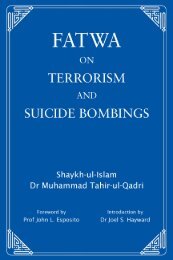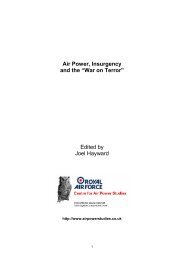Air Power, Insurgency and the âWar on Terrorâ - Prof. Joel Hayward's ...
Air Power, Insurgency and the âWar on Terrorâ - Prof. Joel Hayward's ...
Air Power, Insurgency and the âWar on Terrorâ - Prof. Joel Hayward's ...
You also want an ePaper? Increase the reach of your titles
YUMPU automatically turns print PDFs into web optimized ePapers that Google loves.
Chapter 4<br />
be reaped should it be executed successfully, but also because it represented <str<strong>on</strong>g>the</str<strong>on</strong>g> first<br />
parachute deployment of British troops since <str<strong>on</strong>g>the</str<strong>on</strong>g> crossing of <str<strong>on</strong>g>the</str<strong>on</strong>g> Rhine in March 1945. 135<br />
The SAS took <str<strong>on</strong>g>the</str<strong>on</strong>g> camp with little resistance, denying <str<strong>on</strong>g>the</str<strong>on</strong>g> insurgents a cross-border camp.<br />
The airborne deployment of <str<strong>on</strong>g>the</str<strong>on</strong>g> SAS raises two fur<str<strong>on</strong>g>the</str<strong>on</strong>g>r points regarding <str<strong>on</strong>g>the</str<strong>on</strong>g> indirect role of<br />
air power in Malaya: that of <str<strong>on</strong>g>the</str<strong>on</strong>g> importance of aerial rec<strong>on</strong>naissance, <str<strong>on</strong>g>and</str<strong>on</strong>g> <str<strong>on</strong>g>the</str<strong>on</strong>g> introducti<strong>on</strong><br />
of <str<strong>on</strong>g>the</str<strong>on</strong>g> helicopter.<br />
The SAS were able to locate <str<strong>on</strong>g>the</str<strong>on</strong>g> target camp during Operati<strong>on</strong> Helsby by using maps<br />
that had been drafted from aerial rec<strong>on</strong>naissance photographs of <str<strong>on</strong>g>the</str<strong>on</strong>g> area. Navigati<strong>on</strong>,<br />
ei<str<strong>on</strong>g>the</str<strong>on</strong>g>r by area or <strong>on</strong> <str<strong>on</strong>g>the</str<strong>on</strong>g> ground, was hampered in <str<strong>on</strong>g>the</str<strong>on</strong>g> early stages of <str<strong>on</strong>g>the</str<strong>on</strong>g> Emergency<br />
by <str<strong>on</strong>g>the</str<strong>on</strong>g> absence of any previous extensive survey of <str<strong>on</strong>g>the</str<strong>on</strong>g> country. Photographic<br />
rec<strong>on</strong>naissance was <str<strong>on</strong>g>the</str<strong>on</strong>g>refore crucial in revising old maps in order to ascertain a clearer<br />
picture of <str<strong>on</strong>g>the</str<strong>on</strong>g> topography of <str<strong>on</strong>g>the</str<strong>on</strong>g> country as well as <str<strong>on</strong>g>the</str<strong>on</strong>g> specific locati<strong>on</strong> of insurgent<br />
bases. Aerial rec<strong>on</strong>naissance was also essential for fulfilling <str<strong>on</strong>g>the</str<strong>on</strong>g> military priority of<br />
destroying crops being cultivated by insurgents in jungle clearings in an attempt to<br />
c<strong>on</strong>strict <str<strong>on</strong>g>the</str<strong>on</strong>g>ir ability to survive in hiding. Rec<strong>on</strong>naissance aircraft were used firstly<br />
to identify <str<strong>on</strong>g>and</str<strong>on</strong>g> m<strong>on</strong>itor areas where crops were suspected to be growing, whilst light<br />
aircraft were <str<strong>on</strong>g>the</str<strong>on</strong>g>n called in to spray chemicals from a low height <strong>on</strong>to <str<strong>on</strong>g>the</str<strong>on</strong>g> insurgents’<br />
crops. Between 1952 <str<strong>on</strong>g>and</str<strong>on</strong>g> 1953 RAF helicopters <strong>on</strong> crop-spraying sorties destroyed 88<br />
suspected insurgent cultivati<strong>on</strong> areas. 136 Given <str<strong>on</strong>g>the</str<strong>on</strong>g> high dem<str<strong>on</strong>g>and</str<strong>on</strong>g> <str<strong>on</strong>g>and</str<strong>on</strong>g> prolific usage of<br />
rec<strong>on</strong>naissance aircraft it is little surprise that in <str<strong>on</strong>g>the</str<strong>on</strong>g> final <str<strong>on</strong>g>Air</str<strong>on</strong>g> Ministry analysis of <str<strong>on</strong>g>the</str<strong>on</strong>g><br />
Emergency, it emerged that it was <str<strong>on</strong>g>the</str<strong>on</strong>g> Auster aircraft, used chiefly for rec<strong>on</strong>naissance<br />
purposes, which achieved <str<strong>on</strong>g>the</str<strong>on</strong>g> most flight time, highest number sorties, <str<strong>on</strong>g>and</str<strong>on</strong>g> <str<strong>on</strong>g>the</str<strong>on</strong>g> most<br />
air mileage. 137<br />
The sec<strong>on</strong>d issue highlighted by <str<strong>on</strong>g>the</str<strong>on</strong>g> importance of air power to Special Forces deployment<br />
in Malaya is that of <str<strong>on</strong>g>the</str<strong>on</strong>g> operati<strong>on</strong>al flexibility offered by <str<strong>on</strong>g>the</str<strong>on</strong>g> use of helicopters for both<br />
casualty-evacuati<strong>on</strong> <str<strong>on</strong>g>and</str<strong>on</strong>g> troop-carrying purposes. The medical airlift capacity of <str<strong>on</strong>g>the</str<strong>on</strong>g><br />
helicopter was fully harnessed with <str<strong>on</strong>g>the</str<strong>on</strong>g> introducti<strong>on</strong> of <str<strong>on</strong>g>the</str<strong>on</strong>g> RAF Casualty Evacuati<strong>on</strong> Flight<br />
in May 1950 in Kuala Lumpur, manned initially by just three Royal Navy Drag<strong>on</strong>flies.<br />
These Casualty Evacuati<strong>on</strong> flights proved to be life-saving, particularly during rescue<br />
missi<strong>on</strong>s to collect Special Force troops <strong>on</strong> l<strong>on</strong>g jungle patrols struck down with disease,<br />
or troops severely injured after inherently unsafe parachute drops. 138 By <str<strong>on</strong>g>the</str<strong>on</strong>g> end of 1953<br />
<str<strong>on</strong>g>the</str<strong>on</strong>g>re were three primary helicopter squadr<strong>on</strong>s operating in Malaya. The Evacuati<strong>on</strong><br />
Flight exp<str<strong>on</strong>g>and</str<strong>on</strong>g>ed <str<strong>on</strong>g>and</str<strong>on</strong>g> became 194 Squadr<strong>on</strong>, where <str<strong>on</strong>g>the</str<strong>on</strong>g> Drag<strong>on</strong>flies were replaced with<br />
<str<strong>on</strong>g>the</str<strong>on</strong>g> better performing Sycamore. Troop <str<strong>on</strong>g>and</str<strong>on</strong>g> supply drops were largely fulfilled by 848 <str<strong>on</strong>g>and</str<strong>on</strong>g><br />
155 Squadr<strong>on</strong>s in many areas of dense jungle where <str<strong>on</strong>g>the</str<strong>on</strong>g> vertical take-off capability of <str<strong>on</strong>g>the</str<strong>on</strong>g><br />
helicopters ensured more accurate drops. Accumulatively, <str<strong>on</strong>g>the</str<strong>on</strong>g>se three squadr<strong>on</strong>s formed<br />
303 Wing in 1953 with a total of forty helicopters. 139<br />
<str<strong>on</strong>g>Air</str<strong>on</strong>g> <str<strong>on</strong>g>Power</str<strong>on</strong>g>, <str<strong>on</strong>g>Insurgency</str<strong>on</strong>g> <str<strong>on</strong>g>and</str<strong>on</strong>g> <str<strong>on</strong>g>the</str<strong>on</strong>g> “War <strong>on</strong> Terror” 73





